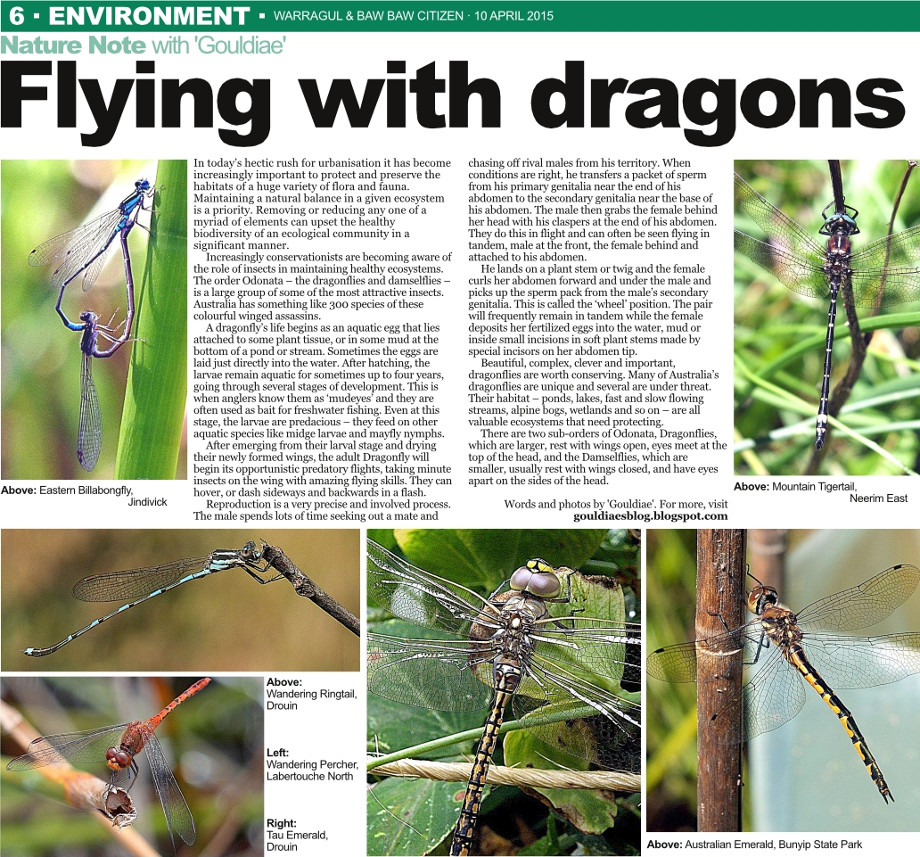
First published in the 10 April 2015 edition of the Warragul & Baw Baw Citizen. Click here to read the full edition online.
In today’s hectic rush for urbanisation it has become increasingly important to protect and preserve the habitats of a huge variety of flora and fauna. Maintaining a natural balance in a given ecosystem is a priority. Removing or reducing any one of a myriad of elements can upset the healthy biodiversity of an ecological community in a significant manner.
Increasingly conservationists are becoming aware of the role of insects in maintaining healthy ecosystems. The order Odonata – the dragonflies and damselflies – is a large group of some of the most attractive insects. Australia has something like 300 species of these colourful winged assassins.
ADVERTISEMENT
A dragonfly’s life begins as an aquatic egg that lies attached to some plant tissue, or in some mud at the bottom of a pond or stream. Sometimes the eggs are laid just directly into the water. After hatching, the larvae remain aquatic for sometimes up to four years, going through several stages of development. This is when anglers know them as ‘mudeyes’ and they are often used as bait for freshwater fishing. Even at this stage, the larvae are predacious – they feed on other aquatic species like midge larvae and mayfly nymphs.
After emerging from their larval stage and drying their newly formed wings, the adult Dragonfly will begin its opportunistic predatory flights, taking minute insects on the wing with amazing flying skills. They can hover, or dash sideways and backwards in a flash.
Reproduction is a very precise and involved process. The male spends lots of time seeking out a mate and chasing off rival males from his territory. When conditions are right, he transfers a packet of sperm from his primary genitalia near the end of his abdomen to the secondary genitalia near the base of his abdomen. The male then grabs the female behind her head with his claspers at the end of his abdomen. They do this in flight and can often be seen flying in tandem, male at the front, the female behind and attached to his abdomen.
He lands on a plant stem or twig and the female curls her abdomen forward and under the male and picks up the sperm pack from the male’s secondary genitalia. This is called the ‘wheel’ position.
ADVERTISEMENT
The pair will frequently remain in tandem while the female deposits her fertilized eggs into the water, mud or inside small incisions in soft plant stems made by special incisors on her abdomen tip.
Beautiful, complex, clever and important, dragonflies are worth conserving. Many of Australia’s dragonflies are unique and several are under threat. Their habitat – ponds, lakes, fast and slow flowing streams, alpine bogs, wetlands and so on – are all valuable ecosystems that need protecting.
There are two sub-orders of Odonata, Dragonflies, which are larger, rest with wings open, eyes meet at the top of the head, and the Damselflies, which are smaller, usually rest with wings closed, and have eyes apart on the sides of the head.
Words and photos by ‘Gouldiae’. For more, visit gouldiaesblog.blogspot.com



